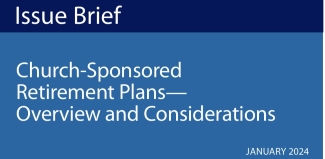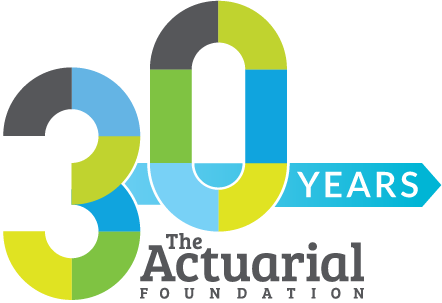Retirement Report, Winter 2024
Vol 7 | No. 1
Date:01/01/2024
Introducing the Retirement Practice Council
By Jason Russell
Retirement Vice President
American Academy of Actuaries

Russell
The Academy’s Board of Directors voted to approve the request from the Pension Practice Council to change its name to the Retirement Practice Council (RPC), which became effective Jan. 31.
The name change has been under consideration for many years. While the practice council has long emphasized the policy considerations and opportunities within the defined benefit pension landscape, we also focus on defined contribution plans, Social Security, retirement policy, and plan designs. Because most of the public policy world refers to this area of interest broadly as “retirement,” the name change will improve our ability to engage with policymakers and elected officials on the breadth of issues the RPC considers.
It is important to keep in mind that while the name of the practice council has changed, its scope and purpose have not. The RPC will continue to prioritize matters related to pension plans, while also continuing its focus on all issues in the retirement income and financial security space. We will continue to collaborate with the casualty, health, life, and risk management and financial reporting councils when our work and public policy interests intersect.
The Academy is in the process of making updates to our various webpages to reflect name change. The change will not be made retroactively, so prior publications will continue to reflect the former name.
The Academy website has been updated to reflect the name change. If you see any pages on our website where you think a change is needed and has not been made, please contact Academy Retirement Policy Analyst Philip Maguire.
Retirement Outlook Featured in Contingencies
Make sure to read “Your Membership in Action,” from the January/February Contingencies, which profiles Academy vice presidents’ outlook for the new year. In “Shaping the future of U.S. retirement with sound analysis of timely issues,” RPC Vice President Jason Russell highlights the Retirement Practice Council’s (formerly the Pension Practice Council) 2024 plans to propel discussions on critical pension and retirement issues within the actuarial community, with policymakers, and among stakeholders.
Areas of focus for the year include managing pension risk in a higher interest rate environment, exploring the potential unfreezing of defined benefit pension plans, conducting a comprehensive retrospective and prospective analysis of the Employee Retirement Income Security Act of 1974 (ERISA) on its 50th anniversary, and actively contributing to the ongoing debate on addressing Social Security solvency. Read Russell’s full report in the issue.
Pension Committee Releases Church Plans Issue Brief

The Pension Committee released an issue brief, Church-Sponsored Retirement Plans—Overview and Considerations, which discusses the broad range of church plans and practices.
Among other considerations, it discusses the impact on a participant of being in a church plan when the ERISA protections and provisions for U.S. tax-qualified single or multiemployer pension plans generally do not apply.
“Because of their exemption from ERISA, church-sponsored plans and plans of church-affiliated hospitals generally have more flexibility than other private pension plans regarding important practices, such as how benefit funding, stability, and security can be managed,” said Academy Senior Retirement Fellow Linda K. Stone. Read the Academy press release.
Learn more: A webinar, hosted in conjunction with the U.S. Government Accountability Office (GAO), will further discuss this topic. Look for more details coming soon.
Social Security Challenge Updated With Latest Data

The Academy’s Social Security Challenge has been updated with information based on the 2023 Social Security Trustees Report, which showed fund reserves are projected to become depleted in 2034—potentially leading to a 20% cut in benefits unless legislative changes are adopted to prevent it. That’s a year earlier than the 2022 Trustees Report projected. The Challenge, released last March, immerses users in a simulated trek through “Townsville,” where users can learn about the program’s challenges and try their hand at various reform proposals. Take the Challenge.
Year-in-Review Public Policy Alert Covers Pension Issues
A year-in-review Academy alert offers highlights of 2023 state and federal legislative and regulatory actions affecting the U.S. actuarial profession and the Academy’s effort to fulfill its role to educate and support our stakeholders on these critical issues.
It includes President Biden’s veto of H.J. Res. 30, which would have barred federal retirement plan managers from considering environmental, social, and governance (ESG) issues in pension investment decisions; Colorado and Maine entering into an agreement to form the nation’s first retirement savings interstate partnership; and several states—including Minnesota, Nevada, and Vermont—approving automatic retirement savings plans.
Your Input Wanted—Cross-Practice ASOP No. 12 Open for Comment
The Actuarial Standards Board approved an exposure draft of a proposed revision of Actuarial Standard of Practice (ASOP) No. 12, Risk Classification (for All Practice Areas), which applies to actuaries with respect to designing, developing, selecting, modifying, reviewing, evaluating, or opining on any elements of a risk classification framework in connection with financial or personal security systems.
Originally adopted in 1989 and last updated in 2005, ASOP No. 12 was developed as the need for more formal guidance on risk classification increased as the selection process became more complex and more subject to public scrutiny. Comments are due by May 1—to weigh in, see the exposure draft.
Issue Paper Examines Social Security & Financially Disadvantaged Groups
A public policy issue paper, Social Security and Financially Disadvantaged Groups, looks at Social Security benefits that are based on earnings but not affected by such factors as race, ethnicity, gender, or other protected classes of Title VII of the Civil Rights Act.
Due to people’s divergent earnings histories, Social Security provides less retirement security for some groups than others, on average. The Social Security Committee discussed this issue regarding gender in its 2017 Women and Social Security issue brief, and the paper extends that discussion to other groups. The issue was also the subject of Envision Tomorrow breakout and poster sessions in November.
Actuary Voices Features Past Senior Pension Fellow Ron Gebhardtsbauer
A recent Actuary Voices episode features a conversation with Ron Gebhardtsbauer, a past Academy senior pension fellow and a co-author of the Social Security and Financially Disadvantaged Groups issue paper. Gebhardtsbauer discusses the paper, his experience as a volunteer, and his contributions to the national conversation on Social Security.
Public Plans Committee Releases Practice Note
The Public Plans Committee released Introduction to Service Purchases for Public Pension Plans, a practice note considering a variety of service purchase programs that can be found across public-sector pension plans, as well as plan administration topics that actuaries should be aware of when working with them.
It was developed to provide an overview of methodologies, considerations, and current practices related to service purchases for public pension plans in the United States, and is intended for use by actuaries providing services to plans of this type.
The practice note states that service purchase provisions can vary widely from plan to plan, and as a result no single approach to pricing service purchases is likely to fit all situations, and professional judgment is required.
Envision Tomorrow Breakout Sessions Look at Social Security, Multiemployer Plans
November’s Envision Tomorrow pension and retirement sessions provided valuable perspectives on key issues including Social Security and financially disadvantaged groups, multiemployer plans, and a pension/life breakout session that examined group annuity contracts for pension risk transfer.
Speakers, panelists, and attendees discussed these and many other topics, interacting with in-person and with virtual attendees. And Frank Todisco, chief actuary of the GAO and a former Academy senior pension fellow, received the Robert J. Myers Public Service Award. Grace Lattyak received an Outstanding Volunteerism Award in recognition of her leadership as vice chairperson of the Pension Committee.
For more coverage of Envision Tomorrow, including a complete rundown of P/C breakout sessions, see Envision Tomorrow—A Closer Look, a supplement to Actuarial Update.
Save the Date for This Year’s Annual Meeting—It’s not too early to save the date for the Academy’s 2024 Annual Meeting, which will be held Oct. 15–16, at the Grand Hyatt Washington in the nation’s capital in advance of the presidential election.
Pension Webinar Looks at Capital Market Conditions
A December webinar, “Capital Market Outlook,” which presented an updated look at economic and capital market conditions, reviewed potential economic outcomes, and provided a summary of return outlooks from an array of published capital market models in a post-COVID economy.
Presenters were Evan Inglis and Pension Committee and Social Security Committee member Jerry Mingione. Maria Moliterno, also a member of the Pension Committee, moderated. An on-demand recording is available to Academy members.
Webinar Examines Pension Risk Transfer
A Jan. 25 pension/life webinar, “Group Annuity Contracts for Pension Risk Transfer,” followed up on the popular Envision Tomorrow breakout session in bringing together subject matter experts for a discussion covering the regulatory and structural evolution of insurance companies that provide pension risk transfer group annuity contracts.
Moderators were Brent Dooley, a member of the Academy Research Committee and the Annuity Reserves and Capital Working Group, and Pension Committee Vice Chairperson Grace Lattyak. An on-demand recording is available as an Academy member benefit.
Highlights From Retirement Report

Prefer to watch your news? Check out this “Highlights From Retirement Report” video for a quick recap of what you need to know.
EBSA Sets Free Webinar Series on Retirement & Health Plans
The U.S. Department of Labor’s Employee Benefits Security Administration (EBSA) will host a free, three-part webinar series in March on fiduciary duties for retirement and health plans. The “Getting It Right—Know Your Fiduciary Responsibilities” webinars are targeted at small-business owners and plan administrators, and will feature EBSA speakers who will address topics including:
- basic fiduciary responsibilities;
- prohibited transactions & exemptions;
- reporting & disclosure requirements; and
- voluntary correction programs.
The webinars will be held on March 5, 13, and 21 from 2 p.m. to 3:30 p.m. Eastern. For information and to register, visit EBSA’s website.
Senior Retirement Fellow Linda K. Stone discussed the need for Social Security reform sooner rather than later in a widely published CNBC story citing the Academy’s recent issue brief on the topic and the Academy’s Social Security Challenge. A subscriber-only Baltimore Sun editorial urging public support of Social Security fixes cited the issue brief, as did Newsweek, Fiscal Times, InvestmentNews, RealClearPolitics, and a syndicated column published in several Pennsylvania newspapers.
The Oklahoma Journal-Record used Academy research in a story on Social Security’s financial condition and reform options.
Legislative/Regulatory Activity
Federal
The Senate voted to confirm Martin O’Malley to serve as commissioner of the Social Security Administration on Dec. 18. O’Malley, nominated by President Biden, is a former Maryland governor and Baltimore mayor. He is the first Senate-approved head of the agency in more than two years.
EBSA issued a proposed rule on Nov. 3. It proposes a new regulatory definition of an investment advice fiduciary for purposes of Title I and Title II of ERISA. The effort is part of an effort by the Biden administration to crack down on retirement advice “junk fees.”
The IRS released final regulations on Jan. 12 on the methodology for constructing the yield curve that underlies how present values are calculated for defined benefit plans. The final regulations are nearly identical to the proposed regulations, with the only difference being a clarification of the methodology.
The IRS released rules in October on the use of mortality tables in pension plans, including proposed and final regulations. The final regulations prescribe “mortality tables to be used for most defined benefit pension plans,” which specify “the probability of survival year-by-year for an individual based on age, gender, and other factors.” The proposed regulations would update requirements that plan sponsors of single-employer defined benefit plans have to meet “to obtain IRS approval to use mortality tables specific to the plan in calculating present value for minimum funding purposes.”
The IRS also issued a notice of proposed rulemaking that would amend rules applicable to plans that include cash or deferred arrangements under section 401(k) to provide guidance with respect to long-term, part-time employees. The proposed regulation, issued Nov. 27, reflects statutory changes made by the SECURE Act and the SECURE 2.0 Act that relate to long-term, part-time employees.
The House Ways & Means Committee approved legislation that allows religious leaders and clergy members who opted out of paying into Social Security to change their minds and qualify for retirement benefits during a two-year window beginning in 2026. HR 6068, which passed Nov. 2, was sponsored by former House Speaker Kevin McCarthy of California, who resigned from Congress on Dec. 31.
Reps. Darrin LaHood of Illinois and Linda Sanchez of California introduced bipartisan legislation that allows retirement savers to roll over their Roth IRA savings into a Roth account within a workplace retirement plan. HR 6757, unveiled Dec. 13, would specifically allow the transfer of contributions from Roth IRA plans to a workplace designated Roth account, such as Roth 401(k), Roth 403(b), or Roth 457(b).
Sens. Bill Cassidy of Louisiana and Tim Kaine of Virginia unveiled a bipartisan bill that provides more Americans ages 18 to 20 with access to employer-sponsored retirement plans. S 3305, introduced Nov. 15, would lower the age for employees to participate in ERISA-covered defined contribution plans to 18 from 21.
The Pension Benefit Guaranty Corporation (PBGC) issued a final rule in December amending its regulation on “Allocation of Assets in Single-Employer Plans” to prescribe interest assumptions under the asset allocation regulation for plans with valuation dates in the first quarter of 2024. These interest assumptions are used for valuing benefits under terminating single-employer plans and for other purposes. The new rule took effect Jan. 1.
The PBGC also issued a final rule that amends the same “Allocation of Assets in Single-Employer Plans” regulation by substituting a new table for determining expected retirement ages for participants in pension plans undergoing distress or involuntary termination with valuation dates falling in 2024. This table is needed to compute the value of early retirement benefits and, thus, the total value of benefits under a plan. The new rule took effect Jan. 1.
State
Lawmakers in Washington state unveiled companion bills (SB 6069/HB 2244) in January that would establish Washington Saves, an automatic enrollment individual retirement savings account program. It is a public-private partnership through which covered employees may, on a voluntary basis, contribute to the state-facilitated, portable retirement savings program.
Rhode Island legislators introduced SB 2045 on Jan. 12, a measure calling for the creation of a retirement savings program to be administered by the Office of the General Treasurer in an effort to promote greater retirement savings for Rhode Island private-sector employees through a voluntary and portable savings vehicle.
New Jersey lawmakers unveiled several bills in early January that would prohibit certain types of investments by the state in its pension and annuity funds, including the 200 largest publicly traded fossil fuel companies (S 198); companies manufacturing, importing, and selling assault firearms for civilian use (S 1115); Chinese pharmaceutical companies (S 1365); and companies involved in the production or maintenance of nuclear weapons (S 1595).
Missouri legislators introduced two bills in January that would regulate investments in the public employee retirement and pension systems by requiring the divestment of holdings in certain Chinese entities or products (HB 1869) as well as from foreign adversaries (HB 2143).
The Washington Department of Labor and Industries issued a new rule lowering the pension discount rate (PDR) to better align with the rate of return for long-term Treasuries for self-insured pensions on Jan. 2. The rule lowers PDR for self-insured employers from 5.6% to 5.5%, effective April 1.
Retirement Public Policy in Brief
The collaborative U.S.-based actuarial organizations’ Intersector Group released notes from its September meetings with the PBGC and the IRS and U.S. Department of the Treasury.

The Actuarial Foundation (TAF) is celebrating its 30th anniversary this year and invites you to play a starring role in commemorating this milestone. Visit actuarialfoundation.org/30th-anniversary/ to learn how you can start celebrating with the foundation today.